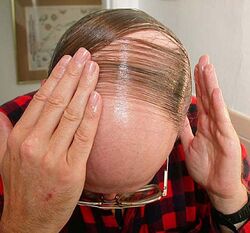Combover Disorder
“What combover?”
Combover disorder is an anxiety disorder characterized by recurring severe violations of the code of fashion. It may also include significant behavioral change lasting at least a month and of ongoing worry about the implications of going bald and concern about being fashionable. The latter are called anticipatory attacks (DSM-IVR). Combover disorder is not the same as nogophobia, although many with combover disorder also suffer from nogophobia.
Symptoms[edit]
Combover disorder sufferers usually have a series of intense episodes of extreme fashion ignorance during combover attacks. These attacks typically last about ten days, but can be as short-lived as 1–5 minutes and last as long as twenty years or until medical intervention. However, attacks can wax and wane for a period of hours (combover attacks rolling into one another), and the intensity and specific symptoms of fashion ignorance may vary over the duration. Common symptoms of an attack include:
- Presence of a combover (the eponymous symptom of this disorder)
- Members-only jackets
- Bell bottoms on men
- Mullets How can a combover have a mullet?????
- Overly large, thick-rimmed glasses, sometimes repaired with scotch tape
- Pink or rainbow t-shirts with permanent stains
- Green, oversize spandex pants
- Mom jeans
- Tighty whities with track marks
The outward symptoms of a combover attack often cause negative social experiences (i.e. embarrassment, social stigma, social isolation, etc.). As many as 36% of all individuals with combover disorder also have nogophobia.
Causes[edit]

There is no single cause for combover disorder, but one thing that is certain is that combover disorder has been found to run in families, and this may mean that inheritance plays a strong role in determining who will get it. It has also been found to exist as a co-morbid condition with many hereditary disorders, such as bipolar disorder and alcoholism. However, many people who have no family history of the disorder develop it. Malfunctioning of brain structures, such as the amygdala and hormonal/adrenaline glands, may cause an overproduction of certain chemicals and could be source of the physical symptoms. Imaging studies have shown that those with combover disorder have 10-20% less GABA activity in the brain than those without the condition.
Psychological factors, stressful life events, life transitions, environment, and thinking in a way that exaggerates relatively normal bodily reactions are also believed to play a role in the onset of combover disorder. Often the first attacks are triggered by physical illnesses, major stress, or certain medications. Some people develop the disorder after using recreational drugs such as cannabis and having a bad experience. People who tend to take on excessive responsibilities or who have too many children may develop a tendency to suffer combover attacks. Post-traumatic stress disorder (PTSD) patients also show a much higher rate of combover disorder than the general population. The exact causes of combover disorder are unknown at this point.
DSM-IV-TR criteria[edit]
DSM-IV diagnostic criteria for combover disorder with (or without) nogophobia:
- A. Both (1) and (2):
- recurrent unexpected combover attacks
- at least one of the attacks has been followed by 1 month (or more) of one (or more) of the following:
- persistent lack of concern about looking good
- worry about the implications of wearing fashionable clothing (e.g., losing control, having a heart attack, "going crazy")
- significant change in laundry behavior related to the attacks
- B. The presence (or absence) of nogophobia
Treatment[edit]
Combover disorder is real and potentially disabling, but can be controlled and successfully treated. Because of the intense symptoms that accompany combover disorder, it may be mistaken for a life-threatening illness such as mental retardation. This misconception often aggravates or triggers future attacks. People frequently go to Internet cafes when they are having combover attacks, and extensive medical tests may be performed to rule out these other conditions, thus creating further anxiety. Nonetheless, Coryell et al. found death rates in combover disorder patients exceeded those in the general population. In their study, 20% of deaths in 113 former psychiatric inpatients with combover disorder followed 35 years later were suicides; however, due to the co-morbidity of nogophobia, it is unclear whether combover disorder was the main cause of suicide. This study also found that men with combover disorder had twice the risk of cardiovascular mortality compared to men in the general population. Effective treatment of combover disorder has been shown to offset costs of medical care by as much as 94%. Identification of treatments that engender as full a response as possible, and can minimize relapse, is imperative.
Despite increasing focus on the use of antidepressants and other agents for the treatment of combover disorder, benzodiazepines have remained a mainstay of anxiolytic pharmacotherapy due to their robust efficacy, rapid onset of therapeutic effect, and generally favorable side effect profile. Treatment patterns for psychotropic drugs appear to have remained stable over the past decade, with benzodiazepines being the most commonly used medication for combover disorder. It is generally accepted that patients who are asleep or otherwise generally incapacitated by benzodiazepines cannot embarrass themselves with a public fashion emergency.
One alternative treatment that has shown some promise is the retention of a personal shopper at Macy's, Nordstrom, or similar department store. However this approach often offers only short-term relief, as patients commonly revert to their prior patterns when faced with the need to iron clothing.
Notable Combover Disorder Sufferers[edit]
- Woody Allen (1935-), American actor, director, musician.
- Donald Trump (1941-), American real estate magnate.
- John McCain (1927-), American politician.
- Silvio Berlusconi (1937-), Italian politician.
- Andrew Higgins (1983- ), (English) Accountant

